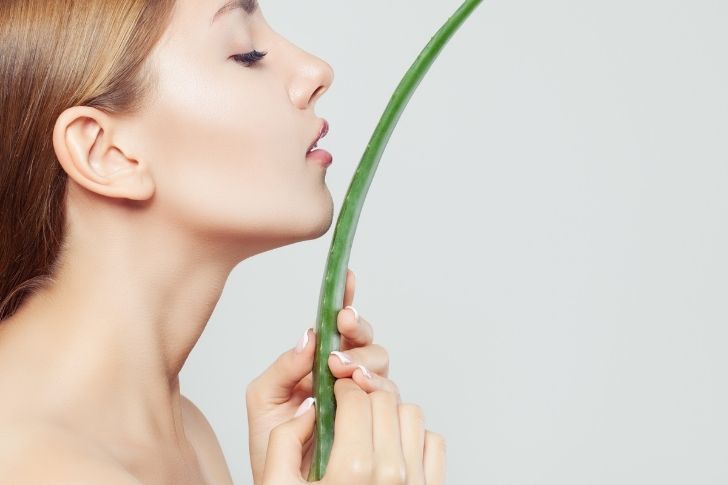As we all know, aloe vera has been used for medicinal purposes for centuries. But do you know the moisturizing and repairing benefits of aloe vera for face?
No home should be without this magical lotion, full of special qualities for our skin. Its regenerative, antioxidant, and anti-inflammatory properties do not go unnoticed.
It moisturizes and cleanses your skin deeply, as well as combating acne and preventing wrinkles. Do you want to know all its properties?
What Is Aloe Vera?
Aloe vera is a plant that has been used for thousands of years to soothe particular pains and help heal wounds.
Classified as medicinal, it belongs to the lily family and has more than 200 active components.
Its minerals, amino acids, vitamins, polysaccharides, enzymes, antioxidants, and fatty acids are key to a radiant complexion.
This miracle remedy has made a significant place in the world of cosmetics due to the large number of results it offers.
Benefits Of Aloe Vera For Face
- It is suitable for all skin types.
- Eliminates dead cells.
- Deeply cleans pore impurities.
- It is an antioxidant.
- Deeply moisturizes and regenerates the skin.
- Provides oxygen to the skin cells.
- Restores skin suppleness and delays the appearance of wrinkles and fine lines.
- Repairs damaged skin.
- Easily absorbed.
- Soothing and anti-inflammatory power.
Aloe is one of the most powerful natural products in existence.
You only have to extract the juice or liquid from its leaves to get the most out of it.
The ingredients of this plant allow its use in your daily beauty routine.
There is no doubt that this is the perfect solution to slow down skin aging, as it stimulates collagen production and improves skin elasticity.
When used with other natural creams and oils, it helps to improve the appearance of our skin and will provide it with greater hydration and elasticity.
Healthy skin is synonymous with vitality and energy.
It works as an emollient and renews damaged skin cells.
This is a product that is neither dangerous nor invasive, so we can use it several times a day to obtain a greater number of benefits and get much more out of its properties.
It should also be noted that acne is a disorder that affects many young people. Aloe vera is a key tool to prevent its appearance and eliminate it.
In addition to its antibacterial properties, the gel has salicylic acid and acts as an exfoliant that unclogs pores while having an anti-inflammatory effect.
At the same time, its enormous cicatrizing capacity avoids later marks. We know that its high soothing and healing power accelerates the healing process.
How To Use Aloe Vera On The Face
Remove makeup
An ideal solution to remove makeup from the face is to apply a little aloe vera with a cotton pad.
This action allows deep cleansing and leaves a fresh sensation on your face, soothing the most delicate areas.
In addition, its astringent properties help to fight blackheads, which will leave the facial skin with a glowing appearance.
Exfoliating effect
Thanks to its high enzyme content, you can apply it directly to the skin and make small circular movements with your fingertips until it is absorbed.
It contains two phytohormones (plant hormones) called auxin and gibberellin, which help promote the formation of new cells and eliminate impurities.
Facial cream: Natural moisturizing
Aloe vera gel is an excellent ally to maintain healthy skin and prevent the appearance of wrinkles. It is moisturizing, nourishing, and soothing.
If you have very dry skin, you can mix it with natural oil, such as coconut oil, for extra hydration.
The most common mode of application is as a moisturizer at night because it maximizes its effects and helps the skin detoxify from its daily activity.
Sunscreen: Stains
You can also use it as a sunscreen because its vitamins will help you prevent the annoying spots that appear on the skin.
Too much sun can become an enemy to a well-groomed and moisturized complexion.
However, it does not protect against skin burns! So make sure you put on a good sunscreen.
Aloe Vera Face Cream: Homemade Recipe
Aloe vera, as we have indicated, is one of the most valued plants in the world in the cosmetic industry for its antibacterial, moisturizing, and astringent properties.
Would you like to prepare your homemade cream? It’s time to share a simple and very useful recipe that guarantees you numerous applications.
Preparing an aloe vera gel or cream is easy and, above all, very useful.
We recommend you do it naturally and organically to take care of the environment and avoid using chemical preservatives.
Use a 100% natural eco-product to benefit from all its advantages.
You will need
- Knife
- Spatula
- Electric mixer (buy here)
- Glass container
Ingredients
- 3 aloe vera leaves
- 1 tablespoon lemon juice
- 1 tablespoon wheat germ oil
Instructions
Once we have the ingredients we have indicated, it is time to start preparing this miraculous lotion.
First, you must make sure that the plant is in the best condition.
You should water it and take care of it before the moment of cutting the three leaves to extract the product you need.
Subsequently, the lateral spines must be removed and placed in a container with water for approximately 24 hours.
The water should be changed every three hours so that the leaves expel a substance known as aloin, which can be toxic.
When the 24 hours have passed, remove them from the water and extract the pulp. To do this, you will have to use a knife to open each leaf from the sides.
Then, with the help of a spatula or spoon, proceed to extract all the gel and add it to a container.
Now, it is time to add lemon juice and wheat germ oil to enhance all its properties.
When all the mixture is in the bowl, it should be beaten at high speed until a thick, white texture is obtained. It is best to use a mixer.
Finally, pour the product into a glass jar and keep it in the refrigerator, as we want it to last as long as possible.
Apply at night, as lemon can cause sun spots if you get sunburned after applying it.
Final Words
Many textures depend on the proportion of aloe vera used, from pure gel to a wide variety of creams, masks, and oils.
In short, aloe vera is a plant full of history and very valuable for its properties and the vast number of benefits it offers for your skin.
Dare you make your lotion?
Aloe Vera Face Cream: Homemade Recipe
You will need
- Knife
- Spatula
- Electric mixer (buy here)
- Glass container
Ingredients
- 3 aloe vera leaves
- 1 tablespoon lemon juice
- 1 tablespoon wheat germ oil
Instructions
- Once we have the ingredients we have indicated, it is time to start preparing this miraculous lotion.
- First, you must make sure that the plant is in the best condition. You should water it and take care of it before the moment of cutting the three leaves to extract the product you need.
- Subsequently, the lateral spines must be removed and placed in a container with water for approximately 24 hours. The water should be changed every three hours so that the leaves expel a substance known as aloin, which can be toxic.
- When the 24 hours have passed, remove them from the water and extract the pulp. To do this, you will have to use a knife to open each leaf from the sides.
- Then, with the help of a spatula or spoon, proceed to extract all the gel and add it to a container.
- Now, it is time to add lemon juice and wheat germ oil to enhance all its properties.
- When all the mixture is in the bowl, it should be beaten at high speed until a thick, white texture is obtained. It is best to use a mixer.
- Finally, pour the product into a glass jar and keep it in the refrigerator, as we want it to last as long as possible.
- Apply at night, as lemon can cause sun spots if you get sunburned after applying it.
If you liked this post, please share it. Save THIS PIN below to your Natural Skin Care board on Pinterest and check it later! 🙂



